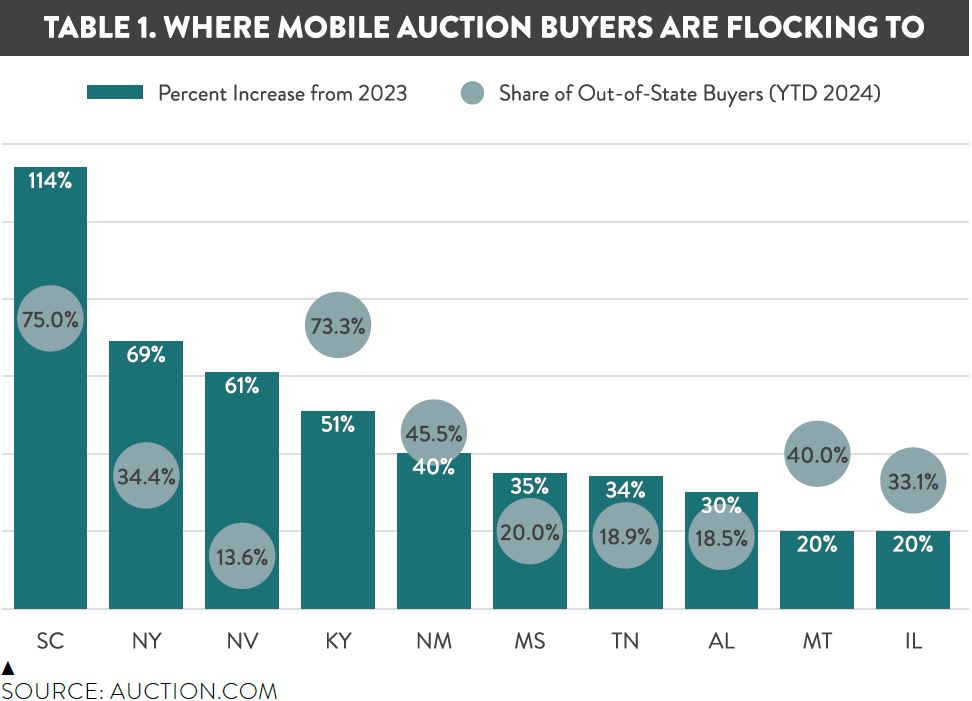Changes are afoot in the real estate market in 2024 as investors flock to emerging hot spots and retreat from traditional strongholds.
The housing market has always been local, and 2024 housing market trends are proving that with substantial market variation in retail inventory, home price appreciation, and even the onset of foreclosures.
These retail trends, in turn, are driving interest from local community developers who buy on Auction.com.
“Chattanooga has just been flooded with investors from California and elsewhere … there are no properties that can be bought and paid for there,” said Steve Johnson, an Auction.com buyer who lives in Chattanooga but decided to start buying properties across the border in Georgia when Chattanooga became out of reach due to prices. “These smaller, less urban counties and cities are gold mines for finding properties that are overlooked by big investors and resellers. But there are a huge number of people looking for a home.”
Sue McCormick, an Atlanta-based buyer for Auction.com, told a similar story.
“I wanted to start investing, but Atlanta is a little expensive,” said McCormick, who decided to start investing in Dayton, Ohio, where he grew up. “I started investing in my hometown because it was easier to get into.”
Tendering activity as a barometer of the retail market
The buying and bidding activity of investors like McCormick and Johnson acts as a reliable barometer of the strength of the local retail market.
Specifically, the proportion of buyers in each market who purchase outside their home market provides insight into which markets are most attractive (and least attractive) to buyers willing and able to invest outside their home market.
These geographically flexible buyers are more likely to target markets based on the underlying strength and opportunity in those markets rather than the convenience and comfort that comes with shopping in their own backyard.
Doing good by doing good
Still, many of these geographically flexible buyers are emotionally connected to the market or markets in which they choose to invest.
“My real passion is going back to the neighborhoods I grew up in and helping improve those areas and making money,” said McCormick, who continues to hold down a regular “day” job even as he invests.
Johnson grew up in Georgia and traveled there frequently for work before retiring several years ago. Helping people buy a home they can afford — something his family was never able to do when he was growing up — is a value close to his heart.
“That’s my market because you’re helping people who don’t have options, and secondly, you don’t have a lot of competition,” he said. “Those stories (of helping people) are just as important as making a profit.”
I'm not rich enough to afford to lose money, but if you do the right thing, you'll have everything you need.
Technology-enabled investor mobility
Technology has allowed even smaller-volume investors like McCormick and Johnson to invest outside their own homes. All bank-owned REO auctions offered on platforms like Auction.com are online, and investors can buy remotely at foreclosure auctions in an increasing number of markets.
The growing opportunity to bid remotely at foreclosure auctions is due to two key developments in recent years. First, changes in state laws have allowed online bidding in some states. Ohio, where McCormick invests, is one example. Second, Auction.com has continued to expand Remote Bid, a technology launched in 2020 that is now available in more than 1,000 counties across the country.
“The difference between remote auction and online auction is that you don’t have to drive or sit in the courthouse,” Johnson said. “With remote auction, I can buy from anywhere.”
States that attract more mobile investors
During the first half of 2024, the states that attracted the largest share of out-of-state buyers on Auction.com were South Carolina (75%), Kentucky (73%), West Virginia (73%), Maryland (56%), and Pennsylvania (48%).
However, the absolute share of out-of-state buyers does not reflect the full reality, as some states are inherently more conducive to out-of-state buyers when there are major metropolitan areas straddling state lines. The best measure is the change in the share of out-of-state buyers so far in 2024 compared to 2023 (see Figure 1).

The states with the largest percentage increase in out-of-state buyers were South Carolina (up 114%), North Carolina (up 69%), Nevada (up 61%), Kentucky (up 51%) and New Mexico (up 40%).
Other states in the top 10 for the largest increase in out-of-state buyer participation include Mississippi (up 35%), Tennessee (up 34%), Alabama (up 30%), Montana (up 20%) and Illinois (up 20%). Georgia, where Johnson invests, was No. 11 on the list with an 18% increase.
States with a decreasing share of mobile investors
At the other end of the spectrum are states with a declining share of out-of-state buyers, an indication that geographically flexible buyers more focused on market strength and opportunity are moving away from those states (see Figure 2).

The states with the largest percentage decrease in out-of-state buyers so far in 2024 compared to 2023 were Washington (down 62%), New Jersey (down 51%), Michigan (down 48%), California (down 46%) and Idaho (down 40%).
Other states in the top 10 with the largest declines in the share of out-of-state buyers were Virginia (down 40%), Indiana (down 35%), Arizona (down 35%), Ohio (down 31%) and Iowa (down 27%).
The states with the lowest share of out-of-state buyers so far in 2024 (typically markets that have not been attractive to geographically flexible buyers for several years) were California (2% of out-of-state buyers so far in 2024), Washington (3%), New York (8%), New Jersey (10%), and Idaho (10%).
Top 25 County Trends
County-level data provides an even more precise view of which local markets are most and least attractive to geographically flexible real estate investors. At the county level, it is beneficial to look at the share of buyers who live outside the county, not out of state. Those buyers still typically represent geographically flexible investors, given that the average U.S. county’s land area is 622 square miles.
Among the top 25 counties by auction sales volume so far in 2024, just over half (13) saw an increase in the share of out-of-county buyers, and just under half (12) saw a decrease in the share of out-of-county buyers.
Those with the largest increases in the share of out-of-county buyers were Sacramento, California (up 196%); Suffolk County (Long Island), New York (up 108%); Shelby County (Memphis), Tennessee (up 106%); Clark County (Las Vegas), Nevada (up 93%); and Los Angeles County, California (up 73%).
The increase in California counties may come as a bit of a surprise, given that only 2% of California property buyers on Auction.com are from out of state. However, some California markets are attracting more geographically flexible investors, primarily from other markets within California. For example, in Sacramento, California, 59% of out-of-county buyers are from Los Angeles County in Southern California, while a combined 18% are from the Bay Area counties of Alameda, Contra Costa and Santa Clara.
The story is different in central U.S. markets such as Shelby/Memphis County, Tennessee, which attracted investors from other counties such as Broward County, Florida, and Alameda County, California, as well as investors from across the border in Desoto County, Mississippi, and about an hour northwest on Interstate 40 in Madison County, Tennessee.
On the other hand, county-level markets that lost traction with geographically flexible investors in the first half of 2024 (see Figure 3) were led by Cook County (Chicago), Illinois, where the share of out-of-county buyers was down 49%, followed by Maricopa County (Phoenix), Arizona (down 48%); Tarrant County (Fort Worth), Texas (down 39%); Fort Bend County (Houston area), Texas (down 39%); and Dekalb County (Atlanta area), Georgia (down 32%).



